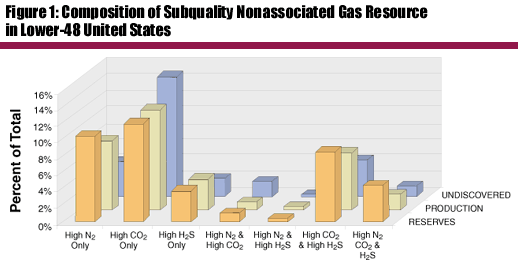
"Volume & Distribution of Subquality Natural Gas in the United States"
GasTIPS
February 2000
For this assessment, GRI defined subquality gas as that characterized by one or more of the following criteria: CO2 content greater than or equal to two percent, N2 content greater than or equal to four percent, and H2S content greater than or equal to four parts per million (ppm). Because these contaminants are often found in combination and because the processing technology options can be different depending upon the mixture, it is important to categorize subquality gas resources by contaminant mixture (CO2 only, CO2 and H2S, and so forth).
The new GRI assessment based on production through 1996, found that 41 percent of proven raw nonassociated gas reserves, 34 percent of production, and 29 percent of the undiscovered resource fits the subquality definition (Table 1). The largest single contaminant appears to be CO2, followed by N2. The combination of CO2 and H2S also is a problem for a significant portion of the resource.

Proven Raw |
1996 Raw |
Undiscovered |
Discovered | ||||
Composition Category |
Bcf |
% |
Bcf |
% |
Bcf |
% |
Bcf |
High Quality Gas |
87,679 |
59% |
11,363 |
66% |
1,193,511 |
71% |
0 |
Subquality Gas |
60,698 |
41% |
5,920 |
34% |
496,042 |
29% |
128,000 |
High N2 Only |
15,617 |
11% |
1,453 |
8% |
74,144 |
4% |
|
High CO2 Only |
17,932 |
12% |
2,102 |
12% |
248,739 |
15% |
|
High H2S Only |
5,691 |
4% |
630 |
4% |
38,572 |
2% |
|
High N2 & High CO2 |
1,577 |
1% |
152 |
1% |
31,932 |
2% |
|
High N2 & High H2S |
600 |
0% |
79 |
0% |
3,324 |
0% |
|
High CO2 & High H2S |
12,697 |
9% |
1,209 |
7% |
77,428 |
5% |
|
High N2, CO2, & H2S |
6,585 |
4% |
296 |
2% |
21,902 |
1% |
128,000 |
Total |
148,377 |
17,283 |
1,689,553 |
128,000 | |||
Roughly the same ratio of reserves to production exists across all of the contaminant combinations (Figure 1). However, high CO2 content gas appears to comprise a slightly larger share of the as yet undiscovered resource, making the case for researchers to look carefully at technologies that can lower the cost or increase the efficiency of CO2 removal.

The volume of gas reserves (both discovered and undiscovered) characterized in this assessment was significantly greater than that of the last study of this kind, done in 1993. The current study encompasses 60.7 Tcf of proven reserves and 496 Tcf of undiscovered resource, compared with 53 Tcf of proven reserves and 308 Tcf of undiscovered resource in the 1993 assessment. This was due primarily to the availability of more comprehensive resource estimates for subquality categories such as coalbed methane in the western basins and the Madison formation of the Green River Basin.
The associated gas characterization was not updated. The previous study estimated that only 13 percent of associated gas reserves were subquality (about 3.3 Tcf), almost entirely due to H2S contamination.
![]()
Business Unit: Producer
Questions or comments about this document, contact: grinet@www.gri.org
This documents URL is -
Printer-Friendly Version - Large documents could take a few minutes to load.